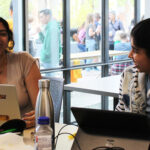
Rittmann makes big challenges seem small
ASU’s Bruce Rittmann is living large and small at the same time.
He’s tackling some of the world’s biggest and most critical technological challenges with some of the tiniest tools.
Rittman directs the Center for Environmental Biotechnology in ASU’s Biodesign Institute and is a professor in the School of Sustainable Engineering and the Built Environment in ASU’s Ira A. Fulton Schools of Engineering.
His biotechnology endeavors focus on microorganisms. These bacteria, algae, archaea and protozoa are too small to be seen by the naked eye, but have a huge impact on the ecology of the Earth and health of its inhabitants.
He and his research partners are using microorganisms to develop ways of providing the world more abundant and clean energy, ensuring the quality of water resources and improving human health.
Progress in the laboratory, along with knowledge of advances in biotechnology that Rittmann brings to the classroom, earned him a Regents’ Professor title earlier this year. It’s the highest honor bestowed on faculty at Arizona’s state universities.
Groundbreaking advances
Since coming to ASU five years ago, after more than a decade at Northwestern University, Rittmann has cemented his standing as a pioneer in work that combines engineering with chemistry and microbiology.
His textbook on environmental biotechnology, co-written with Perry McCarty, a Stanford University emeritus professor, is used in universities throughout the world.
Rittmann’s research results have had demonstrable widespread impact, says Peter Fox, an environmental engineering professor at ASU.
“Bruce’s work on the kinetics and design of biofilm reactors is groundbreaking,” he says. “It’s the basis for hundreds of design models used for practical design and fundamental research. His use of molecular biology for the analysis of biological reactors has become common practice today.“
Neal Woodbury, the deputy director of the Biodesign Institute, calls Rittmann “astounding for his ability to integrate the concepts of microbial ecology, fuel cell technology, water remediation and alternative energy together into a coherent package.”
Rittmann is extraordinary for more the “amazing range” of his expertise, says Paul Westerhoff, the interim director of the School of Sustainable Engineering and the Built Environment.
“Bruce is envisioning large-scale, long-range solutions that have the potential to greatly improve our environment,” Westerhoff says. “He is defining new frontiers in environmental biotechnology, and he is making this possible through his skill in collaborating with colleagues and mentoring students who are working in diverse areas of engineering and science. This productive interaction is Bruce’s signature trait. He motivates people to learn and contribute.”
In 2004, Rittmann was elected to the National Academy of Engineering. He is a Fellow of the American Association for the Advancement of Science, a recipient of the Clarke Prize for Outstanding Achievement in Water Science and Technology, a winner of the prestigious Huber Research Prize and the Freese Award from American Society of Civil Engineers, and among some of the world’s most highly cited researchers in science and engineering journals.
Living in a microbial world
Those achievements stem largely from the depth and diversity of the work he describes simply as “managing microorganisms to provide service” to society.
He’s talking about an especially broad range of services.
Manipulating things at the microbial level is enabling development of renewable bioenergy resources that cause much less pollution than conventional fossil fuels.
For example, microbial fuel cells have the potential to provide clean energy by directly producing electricity or hydrogen from organic matter in waste streams.
Rittmann also is improving methods for removing an array of contaminants from water.
Such promising advances achieved by Rittmann and dozens of other engineers, chemists and biologists at ASU are attracting support from numerous public and private sources.
The reach extends into the medical realm. Rittmann and colleagues are partners with the Mayo Clinic in exploring links between the “microbial populations” in the human body and the risks of diabetes, cardiovascular disease and cancer, among other diseases and maladies.
Facing the avalanche
When he earned his doctorate in environmental engineering from Stanford University three decades ago, the areas in which Rittmann specializes were only just emerging from their infancy. Today, he says, these fields are exploding – giving engineers a sense of exhilaration but also intensifying their challenges.
“With all the new things arising so rapidly from science and engineering, our students need to learn all the old, fundamental things but they also need to know about the avalanche of new knowledge.”
On top of that, scientists and engineers who want to succeed in today’s working environment “need to be good communicators, writers and speakers, learn to work in teams and know about business,” Rittman says. “It’s a tumultuous time for us.”



































